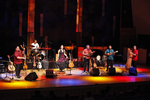Date: Friday, May 7, 2010
Venue: Carnegie Hall/Zankel Hall
Text by Jim Hoey
The critically-acclaimed and Grammy-nominated Sones De Mexico Ensemble took the stage at Carnegie Hall this Friday night to showcase their unique blend of Mexican traditional music, classical, and modern popular song. Using over 30 instruments of Aztec and European origin, this 6-member ensemble expresses the rhythms of Mexico’s varying geographic regions. The different “Son“, or regional folk music styles include son istmeno, jarabes, chilenas, huapangos, and veracruz.
For this night, the 16-year-old group from Chicago (by way of Mexico, of course) started off with a number of traditionals arranged by the ensemble leader Victor Pichardo. The flowing natural arrangements displayed all the technical points you would expect, but veered away from the overly intellectual, and, as all good folk music does, brought an unexpected smile to the audience members’ faces on occasion. The light show was festive and appropriately featured all of the oranges, blues, greens, and browns of Native Mexico. The lone dancer, Lorena Iniguez, was present throughout the night, nimbly accompanying the music with her fluid movements and fast and colorful costume changes, although sadly, not her voice.
Since its beginnings in Chicago in the 1990’s, the Sones De Mexico ensemble has built a large repertoire of songs straight out of the traditionals of Mexico, and has acquired the original instruments necessary to play them. Pichardo and his colleagues are all active in the US and Mexico, and since the beginning of the group they have included classes at schools and free demonstrations as part of their program, in addition to the live shows. In fact, the Ensemble operates as a non-profit, and its latest CD, entitled Fiestas Mexicanas: Mexican Music and Songs for Ninos and Ninas and Their Papas and Mamas, is a bilingual sampler of old standards and originals in English and Spanish for children.
For this night though, they played many songs originally explored on their last album Esta Tierra Es Tuya (“This Land Is Your Land”), including the folk retooling of Led Zeppelin’s “Four Sticks” and J.S. Bach’s “Brandenburg 3-2”. In addition, the second half of the program also featured a tribute to Buck Owens, with versions of “Before You Go” and “Act Naturally”, which, when his manager first heard them, apparently made him spit out his coffee out in surprise.
This version of “Esta Tierra Es Tuya” also comes at a crucial time in US-Mexico affairs, as the controversial Arizona Immigration law looms large over any discussion of cultural exchange and immigration. Woody Guthrie, who wrote “This Land Is Your Land”, also penned two alternative verses not usually included with the well-known classic:
In the squares of the city, In the shadow of a steeple;
By the relief office, I’d seen my people.
As they stood there hungry, I stood there asking,
Is this land made for you and me?
As I went walking, I saw a sign there,
And on the sign there, It said “No Trespassing,” [In another version, the sign reads “Private Property”]
But on the other side, it didn’t say nothing!
That side was made for you and me.
There’s no doubt that Guthrie would approve of the timely appropriation of his Dust Bowl folk ballad and its reworking into a modern protest against the heavy-handed and unjust anti-immigration law that could be used as a pretense for racism and corruption. Yet the Sones De Mexico Ensemble let these gripes simmer under the surface of the exquisite and playful rhythms that they put forward throughout the night, refusing to let political concerns cast a too-heavy shadow over the night’s fun.
They finished with a version of the Ritchie Valens arrangement of “La Bamba”, cutting it and switching back to the traditional form of the song, which is rumored to be over 300 years old. An encore medley followed, featuring clarinet and flamenco tap dancing on one tune called “Cielito Lindo”, and then the night was through.
The balance between the old and the new and the fusion of so many different elements effortlessly lies at the core of this ensemble’s charm. Not many other Mexican groups can represent their roots so deeply and do so much to put the rhythms of Mexico on par with other highly valued folk music traditions that may be perceived as more exotic. In fact, Sones is doing much for American music at a time when many US citizens are forgetting the existence of another part of America, the part that connects to these 50 United States but also extends, with deep historical layers to the south, through Mexico and deeper into Central and South America.


